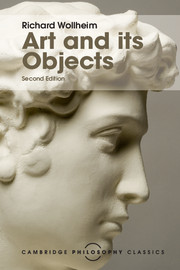Book contents
- Frontmatter
- Dedication
- Contents
- Preface to this edition
- Preface to the second edition
- The argument
- Art and its objects
- Supplementary essays
- 1 The Institutional theory of art
- 2 Are the criteria of identity for works of art aesthetically relevant?
- 3 A note on the physical object hypothesis
- 4 Criticism as retrieval
- 5 Seeing-as, seeing-in, and pictorial representation
- 6 Art and evaluation
- Bibliography
4 - Criticism as retrieval
from Supplementary essays
Published online by Cambridge University Press: 05 November 2015
- Frontmatter
- Dedication
- Contents
- Preface to this edition
- Preface to the second edition
- The argument
- Art and its objects
- Supplementary essays
- 1 The Institutional theory of art
- 2 Are the criteria of identity for works of art aesthetically relevant?
- 3 A note on the physical object hypothesis
- 4 Criticism as retrieval
- 5 Seeing-as, seeing-in, and pictorial representation
- 6 Art and evaluation
- Bibliography
Summary
It is a deficiency of at least the English language that there is no single word, applicable over all the arts, for the process of coming to understand a particular work of art. To make good this deficiency I shall appropriate the word ‘criticism’, but in doing so I know that, though this concurs with the way the word is normally used in connection with, say, literature, it violates usage in, at any rate, the domain of the visual arts, where ‘criticism’ is the name of a purely evaluative activity.
The central question to be asked of criticism is, What does it do? How is a piece of criticism to be assessed, and what determines whether it is adequate? To my mind the best brief answer, of which this essay will offer an exposition and a limited defence, is, Criticism is retrieval. The task of criticism is the reconstruction of the creative process, where the creative process must in turn be thought of as something not stopping short of, but terminating on, the work of art itself. The creative process reconstructed, or retrieval complete, the work is then open to understanding.
To the view advanced, that criticism is retrieval, several objections are raised.
The first objection is that, by and large, this view makes criticism impossible: and this is so because, except in exceptional circumstances, it is beyond the bounds of practical possibility to reconstruct the creative process.
Any argument to any such conclusion makes use of further premisses – either about the nature of knowledge and its limits, or about the nature of the mind and its inaccessibility – and the character of these further premisses comes out in the precise way the conclusion is formulated or how it is qualified. For, though an extreme form of the objection would be that the creative process can never be reconstructed, the conclusion is likelier to take some such form as that criticism is impossible unless the critic and the artist are one and the same person, or the work was created in the ambience of the critic, or the creative process was fully, unambiguously, and contemporaneously documented by the artist.
- Type
- Chapter
- Information
- Art and its Objects , pp. 124 - 136Publisher: Cambridge University PressPrint publication year: 2015
- 4
- Cited by



